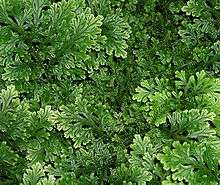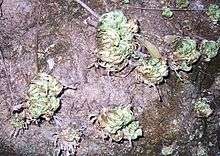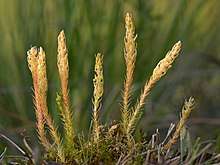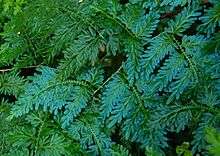Selaginella
Selaginella is the sole genus of vascular plants in the family Selaginellaceae, the spikemosses or lesser clubmosses.
| Spikemoss | |
|---|---|
 | |
| Scientific classification | |
| Kingdom: | Plantae |
| Clade: | Tracheophytes |
| Clade: | Lycophytes |
| Class: | Lycopodiopsida |
| Order: | Selaginellales Prantl |
| Family: | Selaginellaceae Willk. |
| Genus: | Selaginella P. Beauv. |
| Species | |
|
See text | |

This family is distinguished from Lycopodiaceae (the clubmosses) by having scale-leaves bearing a ligule and by having spores of two types. They are sometimes included in an informal paraphyletic group called the "fern allies". S. moellendorffii is an important model organism. Its genome has been sequenced by the United States Department of Energy's Joint Genome Institute.[1] The name Selaginella was erected by Palisot de Beauvois solely for the species Selaginella selaginoides, which turns out (with the closely related Selaginella deflexa) to be a clade that is sister to all other Selaginellas, so any definitive subdivision of the species into separate genera leaves two taxa in Selaginella, with the hundreds of other species in new or resurrected genera.
Selaginella occurs mostly in the tropical regions of the world, with a handful of species to be found in the arctic-alpine zones of both hemispheres.[2]
Description
Selaginella species are creeping or ascendant plants with simple, scale-like leaves (microphylls) on branching stems from which roots also arise. The stems are aerial, horizontally creeping on the substratum (as in Selaginella kraussiana), sub erect (Selaginella trachyphylla) or erect (as in Selaginella erythropus). The vascular steles are polystelic protosteles. stem section shows the presence of more than two protosteles. Each stele is made up of diarch (centre of origin on the inside, later cells are added centrifugally) and exarch (centre of origin located laterally, later cells are added centripedally) xylem in centre. The steles are connected with the cortex by means of many tube-like structures called trabeculae, which are modified endodermal cells with casparian strips on their lateral walls. The stems contain no pith.
Unusually for the lycopods, which generally have microphylls with a single unbranched vein, the microphylls of Selaginella species contain a branched vascular trace. In Selaginella, each microphyll and sporophyll has a small scale-like outgrowth called a ligule at the base of the upper surface.[3]:7 The plants are heterosporous with spores of two different size classes, known as megaspores and microspores.
Under dry conditions, some species of Selaginella can survive dehydration. In this state, they may roll up into brown balls and be uprooted, but can rehydrate under moist conditions, become green again and resume growth. This phenomenon is known as poikilohydry, and poikilohydric plants such as Selaginella bryopteris are sometimes referred to as resurrection plants.
Taxonomy
Some scientists still place the Selaginellales in the class Lycopodiopsida (often misconstructed as "Lycopsida"). Some modern authors recognize three generic divisions of Selaginella: Selaginella, Bryodesma Sojak 1992, and Lycopodioides Boehm 1760. Lycopodioides would include the North American species S. apoda and S. eclipes, while Bryodesma would include S. rupestris (as Bryodesma rupestre). Stachygynandrum is also sometimes used to include the bulk of species.
The first major attempt to define and subdivide the group was by Palisot de Beauvois[4] in 1803-1805. He established the genus Selaginella as a monotypic genus, and placed the bulk of species in Stachygynandrum. Gymnogynum was another monotypic genus, but that name is superseded by his own earlier name of Didiclis. This turns out, today, to be a group of around 45-50 species also known as the Articulatae, since his genus Didiclis/Gymnogynum was based on Selaginella plumosa. He also described the genus Diplostachyum to include a group of species similar to Selaginella apoda. Spring inflated the genus Selaginella to hold all selaginelloid species four decades later.
Phylogenetic studies by Korall & Kenrick[5][6] determined that the Euselaginella group, comprising solely the type species, Selaginella selaginoides and a closely related Hawaiian species, Selaginella deflexa, is a basal and anciently diverging sister to all other Selaginella species. Beyond this, their study split the remainder of species into two broad groups, one including the Bryodesma species, the Articulatae, section Ericetorum Jermy and others, and the other centered on the broad Stachygynandrum group.
Walton & Aston classification
In the Manual of Pteridology,[7] the following classification was used by Walton & Alston:
genus: Selaginella
- subgenus: Euselaginella
- group: selaginoides
- group: pygmaea
- group: uliginosa (Ericetorum)
- group: rupestris (Tetragonostachys or Bryodesma)
- subgenus: Stachygynandrum
- series: Decumbentes
- series: Ascendentes
- series: Sarmentosae
- series: Caulescentes
- series: Circinatae
- series: Articulatae
- subgenus: Homostachys
- subgenus: Heterostachys
However, this is now known to be highly paraphyletic in most of its groupings. Two recent classifications, employing modern methods of phylogenetic analysis, are as follows:
Weststrand & Korall, 2016 classification
genus: Selaginella
- subgenus: Selaginella
- clade: "Rhizophoric clade"
- clade A
- subgenus Rupestrae (=Bryodesma Sojak or Tetragonostachys Jermy)
- subgenus Lepidophyllae (Selaginella lepidophylla)
- subgenus Gymnogynum
- subgenus Exaltatae
- subgenus Ericetorum (=Ericetorum Jermy)
- clade B
- subgenus Stachygynandrum
- clade A
Zhang & Zhou, 2015 classification
genus: Selaginella
- subgenus: Selaginella Type: Selaginella selaginoides (L.) P.Beauv. ex Mart. & Schrank
- subgenus: Boreoselaginella Type: Selaginella sanguinolenta (L.) Spring
- subgenus: Ericetorum Type: Selaginella uliginosa (Labill.) Spring
- section: Lyallia Type: Selaginella uliginosa (Labill.) Spring
- section: Myosurus Type: Selaginella myosurus Alston
- section: Megalosporarum Type: Selaginella exaltata (Kunze) Spring
- section: Articulatae Type: Selaginella kraussiana (Kunze) A.Braun
- section: Homoeophyllae Type: Selaginella rupestris (L.) Spring (=Bryodesma Sojak or Tetragonostachys Jermy)
- section: Lepidophyllae Type: Selaginella lepidophylla (Hook. & Grev.) Spring
- subgenus: Pulviniella Type: Selaginella pulvinata (Hook. & Grev.) Maxim
- subgenus: Heterostachys Type: Selaginella heterostachys Baker
- section: Oligomacrosporangiatae Type: Selaginella uncinata (Desv. ex Poir.) Spring
- section: Auriculatae Type: Selaginella douglasii (Hook. & Grev.) Spring
- section: Homostachys Type: : Selaginella helvetica (L.) Link
- section: Tetragonostachyae Type: Selaginella proniflora (L.) Baker
- section: Heterostachys Type: Selaginella brachystachya (Hook. & Grev.) Spring
- subgenus: Stachygynandrum Type: Selaginella flabellata (L.) Spring
- section: Plagiophyllae Type: Selaginella biformis A.Braun ex Kuhn
- section: Circinatae Type: Selaginella involvens (Sw.) Spring
- section: Heterophyllae Type: Selaginella flexuosa Spring
- section: Austroamericanae Type: Selaginella hartwegiana Spring
- section: Pallescentes Type: S. pallescens (C.Presl) Spring
- section: Proceres Type: Selaginella oaxacana Spring
- section: Ascendentes Type: Selaginella alopecuroides Baker
Species


There are about 750 known species of Selaginella.[10] They show a wide range of characters; the genus is overdue for a revision which might include subdivision into several genera. Better-known spikemosses include:
- Selaginella apoda – meadow spikemoss; eastern North America
- Selaginella arizonica Maxon – west Texas to Arizona and Sonora, Mexico
- Selaginella asprella
- Selaginella bifida – Rodrigues Island
- Selaginella biformis
- Selaginella bigelovii
- Selaginella braunii – Braun's spikemoss; China
- Selaginella bryopteris – sanjeevani; India
- Selaginella canaliculata – clubmoss; southeast Asia, Maluku Islands
- Selaginella carinata
- Selaginella cinerascens
- Selaginella densa – lesser spikemoss; western North America
- Selaginella denticulata
- Selaginella eclipes – hidden spikemoss; eastern North America
- Selaginella elmeri
- Selaginella eremophila Maxon
- Selaginella erythropus
- Selaginella galotteii
- Selaginella hansenii
- Selaginella kraussiana – Krauss's spikemoss; Africa, Azores
- Selaginella lepidophylla – resurrection plant, dinosaur plant, and flower of stone; Chihuahuan Desert, North America
- Selaginella martensii – variegated spikemoss
- Selaginella moellendorffii
- Selaginella oregana
- Selaginella plana – Asian spikemoss; tropical Asia
- Selaginella poulteri
- Selaginella pulcherrima
- Selaginella rupestris – rock spikemoss, festoon pine, and northern Selaginella (eastern North America)
- Selaginella rupincola Underw. – west Texas to Arizona and Sonora, Mexico
- Selaginella selaginoides – lesser clubmoss; north temperate Europe, Asia and North America)
- Selaginella sericea A.Braun – Ecuador
- Selaginella serpens
- Selaginella sibirica
- Selaginella stellata – starry spikemoss; Mexico, Central America
- Selaginella substipitata
- Selaginella tamariscina
- Selaginella tortipila
- Selaginella uliginosa – Australia
- Selaginella umbrosa
- Selaginella uncinata – peacock moss, peacock spikemoss, blue spikemoss
- Selaginella underwoodii Hieron. – west Texas to Wyoming and west into Arizona
- Selaginella wallacei
- Selaginella watsonii
- Selaginella willdenowii – Willdenow's spikemoss, peacock fern; southeast Asia
A few species of Selaginella are desert plants known as "resurrection plants", because they curl up in a tight, brown or reddish ball during dry times, and uncurl and turn green in the presence of moisture. Other species are tropical forest plants that appear at first glance to be ferns.
Cultivation
A number of Selaginella species are popular plants for cultivation, mostly tropical species. Some of the species popularly cultivated and actively available commercially include:
- S. kraussiana: golden clubmoss
- S. moellendorffii: gemmiferous spikemoss
- S. erythropus: red selaginella or ruby-red spikemoss
- S. uncinata: peacock moss
- S. lepidophylla: resurrection plant
- S. braunii: arborvitae fern
References
- "Selaginella moellendorffii v1.0". Joint Genome Institute. United States Department of Energy. 2007. Retrieved 2009-04-08.
- http://pza.sanbi.org/selaginella-kraussiana
- Stace, C. A. (2010). New Flora of the British Isles (Third ed.). Cambridge, U.K.: Cambridge University Press. ISBN 9780521707725.
- Palisot de Beauvois (1805): Prodrome des cinquième et sixième familles de l'Æthéogamie, les mousses, les lycopodes.
- Korall, P. & Kenrick, P. (2002), "Phylogenetic relationships in Selaginellaceae based on rbcL sequences", American Journal of Botany, 89 (3): 506–17, doi:10.3732/ajb.89.3.506, PMID 21665649
- Korall & Kenrick (2004): The phylogenetic history of Selaginellaceae based on DNA sequences from the plastid and nucleus: extreme substitution rates and rate heterogeneity. Molecular Phylogenetics and Evolution, Volume 31, Issue 3, June 2004, Pages 852-864
- Verdoorn, F., ed. (1938): Manual of Pteridology: J. Walton and A. H. G. Alston, Lycopodinae, pp. 500-506. Martinus Nijhoff, The Hague. 640pp, HB.
- Weststrand, Stina; Korall, Petra (2016), "A subgeneric classification of Selaginella (Selaginellaceae)", American Journal of Botany, 103 (12): 2160–2169, doi:10.3732/ajb.1600288, PMID 27999080
- Zhou, Xin-Mao; Zhang, Li-Bing (2015), "A classification of Selaginella (Selaginellaceae) based on molecular (chloroplast and nuclear), macromorphological, and spore features", Taxon, 64 (6): 1117–1140, doi:10.12705/646.2
- Christenhusz, M. J. M. & Byng, J. W. (2016). "The number of known plants species in the world and its annual increase". Phytotaxa. 261 (3): 201–217. doi:10.11646/phytotaxa.261.3.1.
External links

